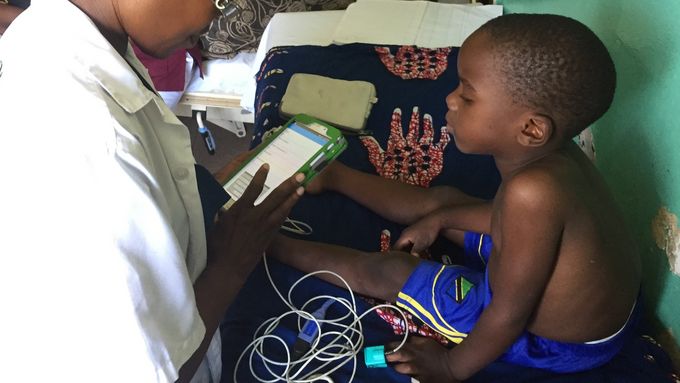Digital Tools Help Identify Severe Illness, but Hospital Access Remains a Barrier
14.07.2025
A study coordinated by Swiss TPH, in collaboration with partners in India, Kenya, Senegal and Tanzania, has found that introducing pulse oximeters and digital clinical decision support tools into primary healthcare can support the identification of severe illness in children and reduce the use of antibiotics. However, without stronger referral systems and better hospital access, the potential of these tools to improve health outcomes remains limited.

Children under five years of age in low- and middle-income countries (LMICs) face a high burden of preventable illness and death. Hypoxaemia (low blood oxygen levels) is strongly associated with a higher risk of death in sick children, yet it is often missed during routine check-ups. Two promising tools – pulse oximeters and digital clinical decision support algorithms (CDSAs) – can help address this challenge. Pulse oximetry is a simple, non-invasive and reliable method to detect hypoxaemia and CDSAs are digital, tablet-based tools that guide health workers step by step through a child’s assessment and treatment. Despite their potential, however, evidence of the real-world impact of these tools on health outcomes has been limited.
Largest study of its kind in primary care settings
Two major studies from the Tools for Integrated Management of Childhood Illness (TIMCI) consortium evaluated whether these tools, when introduced in primary care, could improve referral, hospitalization, and mortality outcomes in sick children under five.
Conducted across Kenya, Senegal, India and Tanzania, the studies enrolled over 200,000 children in 260 primary care facilities, where pulse oximetry and CDSAs were introduced as part of the large-scale Unitaid-funded TIMCI project between 2019 and 2024. Findings, published in eClinicalMedicine (part of The Lancet Discovery Science), show that the introduction of these tools improved some aspects of clinical care for sick children under five but did not consistently lead to better access to hospital-level treatment or reductions in severe complications.
The studies found that health workers were able to detect cases of hypoxaemia using pulse oximetry, though prevalence overall was low. In India and Tanzania, the tools were associated with small but measurable increases in both urgent referrals and completed referrals. This pattern was not observed in Kenya and Senegal, where referral rates remained largely unchanged. Across all four countries, many children with hypoxaemia or other signs of severe illness were either not referred to higher level of care, did not complete referral, or were not hospitalised within 24 hours. Barriers included transport and cost constraints, concerns about hospital care quality, and power dynamics affecting caregiver decision-making. Severe complications, which included deaths or delayed and unplanned hospitalisations, remained largely unchanged.
“These studies confirms that these tools can strengthen certain aspects of clinical assessment,” said Fenella Beynon, Head of the Digital Health unit at Swiss TPH and clinical coordinator of TIMCI. “But they are not enough on their own. Without addressing systemic barriers to referral and hospital care, their impact on health outcomes will remain limited.”
Reduced unnecessary antibiotic prescriptions
In Kenya and Senegal, the introduction of the tools was associated with a substantial reduction in unnecessary antibiotic prescriptions. The use of antibiotics fell by 14.6% in young infants and by 22.6% in older children, with no evidence of harm or difference in caregiver-reported recovery. This indicates that digital tools can help reduce over-prescription of antibiotics in settings where antibiotics are frequently overused, which is a key strategy in the global effort to combat antimicrobial resistance.
“We saw how clinical decision support can reinforce clinical judgement and build confidence in not prescribing antibiotics when they’re not needed,” said Hélène Langet, coordinating data manager of TIMCI. “But the fact that we didn’t see the same impact everywhere shows that prescribing behaviours are shaped by the local health system context and day-to-day realities of care.”
Looking ahead: strengthening the system
The authors emphasise that future implementation strategies should take a health systems perspective – addressing barriers not only at the primary care level but across the entire continuum of care. Improving referral pathways, reducing obstacles to hospital access, and ensuring quality care at all levels will be essential to unlocking the full potential of these diagnostic tools to improve child health outcomes.
About the TIMCI project
The study was conducted as part of the Unitaid-funded Tools for Integrated Management of Childhood Illness (TIMCI) project, led by a consortium including PATH, Swiss TPH, UniSanté, Susan Horton, Ifakara Health Institute, King George’s Medical University, University of Nairobi and Université Cheick Anta Diop de Dakar, and in partnership with respective national Ministries of Health.
About the publications
Beynon, F, Mhalu G, Kumar D et al. Effectiveness of introducing pulse oximetry and clinical decision support algorithms for the management of sick children in primary care in India and Tanzania on hospitalisation and mortality: the TIMCI pragmatic cluster randomised controlled trial. eClinicalMedicine, Volume 85, 103306
Langet, H, Faye P M, Njiri F et al. Effectiveness of introducing pulse oximetry and clinical decision support algorithms for the management of sick children in primary care in Kenya and Senegal on referral and antibiotic prescription: the TIMCI quasi-experimental pre-post study. eClinicalMedicine, Volume 83, 103196
Stay connected
Subscribe to our newsletter and get all the latest research news, project updates, course and event listings from Swiss TPH.
